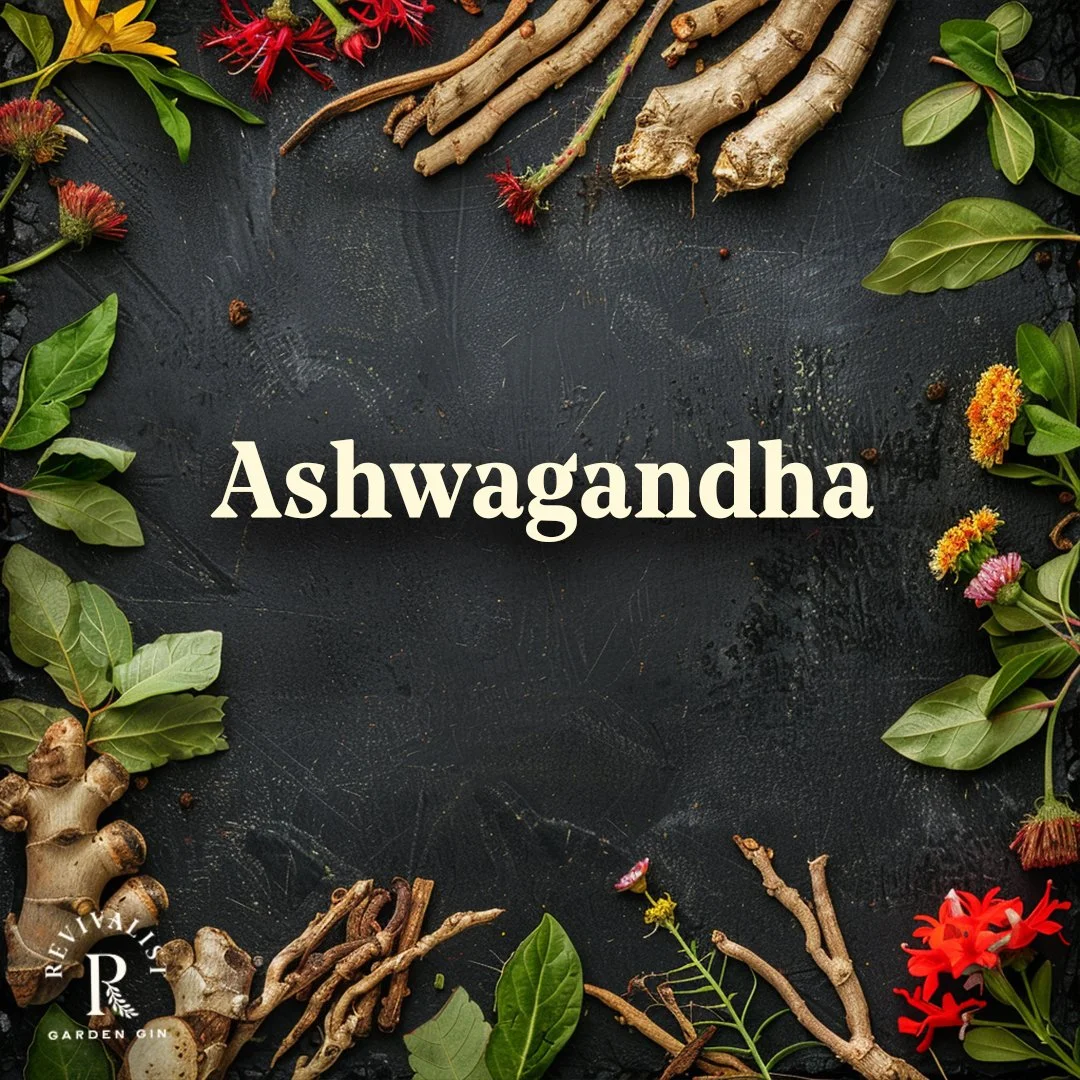ETHNOBOTANICAL GUIDE
Welcome to the amazing and diverse world of plants. In this Ethnobotanical Guide, you can embark on a botanical adventure exploring their history, uses, and nutrient-rich offerings. Whether you're satisfying a budding interest in plants, curious about what’s in your cocktail, or want to deepen your understanding of nature, we hope you’ll find useful information here.
ASHWAGANDHA
Used by cultures for thousands of years, Ashwagandha is one of the most important herbs in Ayurveda, a form of holistic medicine based on Indian principles of natural healing. It holds the esteemed position as a Rasayana, an herbal preparation believed to promote a youthful state of physical and mental health that expands happiness.
One of Ashwagandha’s superpowers is its unique ability to reduce stress and anxiety. Ashwagandha promotes a sense of calmness and relaxation by helping to regulate cortisol levels, which are often elevated during times of stress. It is used to improve sleep quality by helping individuals fall asleep faster and promoting a deeper, more restorative sleep experience.
Studies also suggest that ashwagandha may enhance cognitive function, including memory, attention, and information processing speed. Ashwagandha has been recognized for its immune-modulating and anti-inflammatory properties and is used to increase strength and endurance and to support sexual health.
The nutrients and chemicals in ashwagandha work together synergistically to provide a wide range of health benefits. It contains withanolides, naturally occurring steroid lactones that are unique to the Solanaceae family of plants, which includes ashwagandha. These compounds are believed to be responsible for many of the herb's medicinal properties, including its adaptogenic and anti-inflammatory effects. Ashwagandha also contains amino acids, flavonoids, tannins, saponins, and phenolic compounds, which have antioxidant as well as anti-inflammatory properties. While ashwagandha is not a significant source of vitamins and minerals, it does contain small amounts of nutrients such as iron, calcium, magnesium, vitamin C, and vitamin B-complex.
HEMP
Cultivated for thousands of years, hemp dates back to ancient China and Mesopotamia. It has served a wide variety of uses, playing a crucial role in different civilizations as textiles, paper, rope, building materials, and more.
Hemp is a cultivar of Cannabis sativa but does not have the THC content to cause a psychoactive effect. However, due to its association with marijuana, it also faced legal restrictions, but with legalization in many countries, it has experienced a resurgence in recent years. Entire segments of food, beverage, and skin care products have emerged featuring hemp, as well as new renewable and sustainable energy sources.
Technically a nut, not a seed, hemp is one of the fastest growing plants on earth and a nutritional powerhouse, rich in protein, omega-3 fatty acids, vitamins B and E, and an array of minerals, which contribute to overall health and well-being. It is also high in fiber, which promotes digestive health and satiety, and loaded with phytonutrients, which have antioxidant and anti-inflammatory properties.
JUNIPER
Since prehistoric times, people have relied on juniper for food, fuel, and shelter. The ancient Egyptian, Greek, and Roman civilizations used juniper as a purifying and spiritual agent, culinary ingredient, and digestive aid. An Egyptian papyrus from 1500 BC contains a recipe with juniper to cure tapeworm infestations, and it has been found in tombs as well. In Native American cultures, juniper has been used in food preparation and sacred rituals.
The juniper berry has a distinctive tart and piney fruitiness and is an essential element in traditional gin. High in vitamin C, flavonoids, terpenes, tannins, and other compounds, juniper has been shown to have antioxidant, anti-inflammatory, antibacterial, antiviral, and antifungal activity, which are traced back to a volatile oil found in the berries. Resins and tars found in juniper are believed to benefit skin conditions such as psoriasis. While not a significant source of vitamins or minerals, juniper berries provide small amounts of vitamin C and trace minerals like manganese and iron.
LEMON VERBENA
Lemon verbena is a fragrant, perennial shrub native to South America that has been used for centuries for a variety of medicinal and culinary purposes. In the 17th century, Spanish explorers brought lemon verbena back to Europe where it quickly took root in European culture and became a sought-after garden herb for its aromatic lemon scent.
In many cultures it symbolizes love, protection, and purification and is brewed and consumed as a tea for its digestive and calming effects. Also commonly used in aromatherapy to promote relaxation and reduce stress, lemon verbena’s refreshing scent can be found in candles, essential oils, and potpourri blends.
Rich in vitamins A, C, and E, lemon verbena has antioxidant activity that helps protect cells from damage caused by free radicals. It contains minerals such as calcium, iron, magnesium, and potassium, which are essential for various bodily functions, and polyphenols, which also have antioxidant and anti-inflammatory properties.
PLUM
For thousands of years, plums have been valued not only for their sweet and tart flavor but also for their medicinal properties. They are believed to have originated in ancient China, where they were revered as a symbol of good fortune, longevity, and prosperity. They spread to Europe and other parts of the world through trade routes and eventually were cultivated around the globe.
In traditional and herbal medicine, plums have been used to treat various ailments, including digestive issues, respiratory problems, and skin conditions.
Packed with more than 15 essential vitamins and minerals, plums are high in fiber and low in calories, making them ideal for weight management. This powerhouse plant is also high in polyphenol antioxidants, which demonstrate anti-inflammatory properties, vitamin C, which boosts the immune system and promotes healthy skin, potassium, which helps regulate blood pressure and muscle function, and vitamin K, which is important for bone health and blood clotting. With all these nutrients, it’s not unreasonable to think, a plum a day…
ROSE HIPS
We don’t often think of roses as bearing fruit, but that’s exactly what rose hips are: the fruit of the rose plant. Filled with seeds, it’s the small bulb that sits just below the petals of the flower. The Greeks, Romans, and Egyptians recognized the nutritional and medicinal value of rose hips since ancient times, with evidence of their use dating back to the Stone Age. During the Middle Ages, rose hips were used to treat various ailments, including colds, flu, and digestive issues.
In Ayurvedic and traditional Chinese medicine, rose hips are believed to have anti-inflammatory, antioxidant, and immune-boosting effects. Rose hip tea, oil, or extracts are used to treat conditions such as arthritis, colds, flu, and digestive issues.
Loaded with vitamins A, B5, C, E, and K, rose hips are high in antioxidants and are used today as a nutritional supplement or a tea to boost the immune system and overall health. Believed to have anti-aging and moisturizing properties, they are also used in skincare products.
You won’t find a better natural source of vitamin C than rose hips, which contain even more than most citrus fruits, including oranges. They are also rich in carotenoids (including beta-carotene), flavonoids, which are associated with anti-inflammatory activity, and essential fatty acids.
ROSE PETALS
The rose reigns as an iconic symbol of love, romance, and beauty. Yet it is also revered by many cultures for its ethnobotanical virtues, ranging from flavoring jams and cakes to herbal remedies. It is believed that roses have been cultivated for more than 5,000 years and were first used in traditional Chinese medicine as a tea to regulate qi or life energy.
Rose petals are used in aromatherapy to reduce stress and anxiety and promote relaxation. In addition to its calming effect, they are also used in a variety of beauty products for their soothing and moisturizing properties.
Research shows that rose petals are high in phytonutrients with antioxidant properties and are a good source of vitamins A, E, and C, which can boost the immune system and promote healthy skin. They also contain minerals like calcium, magnesium, and potassium, which are important for bone health, muscle function, and electrolyte balance.








